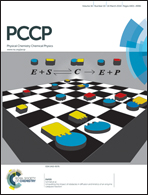On the interpretation of domain averaged Fermi hole analyses of correlated wavefunctions
Abstract
Few methods allow for a physically sound analysis of chemical bonds in cases where electron correlation may be a relevant factor. The domain averaged Fermi hole (DAFH) analysis, a tool firstly proposed by Robert Ponec in the 1990's to provide interpretations of the chemical bonding existing between two fragments Ω and Ω′ that divide the real space exhaustively, is one of them. This method allows for a partition of the delocalization index or bond order between Ω and Ω′ into one electron contributions, but the chemical interpretation of its parameters has been firmly established only for single determinant wavefunctions. In this paper we report a general interpretation based on the concept of excluded density that is also valid for correlated descriptions. Both analytical models and actual computations on a set of simple molecules (H2, N2, LiH, and CO) are discussed, and a classification of the possible DAFH situations is presented. Our results show that this kind of analysis may reveal several correlated assisted bonding patterns that might be difficult to detect using other methods. In agreement with previous knowledge, we find that the effective bond order in covalent links decreases due to localization of electrons driven by Coulomb correlation.


 Please wait while we load your content...
Please wait while we load your content...